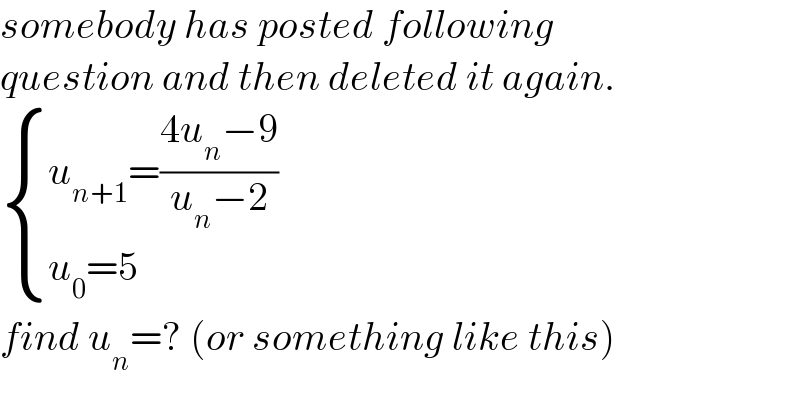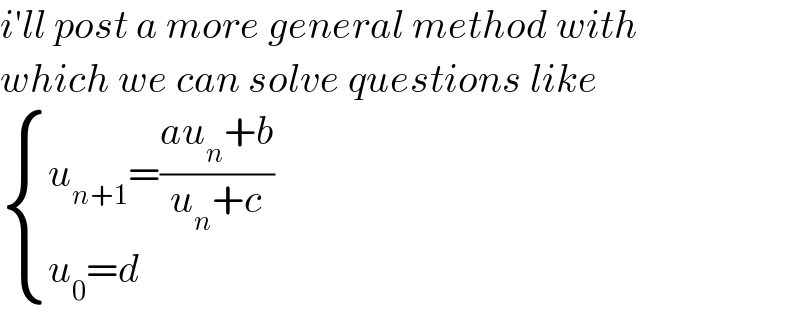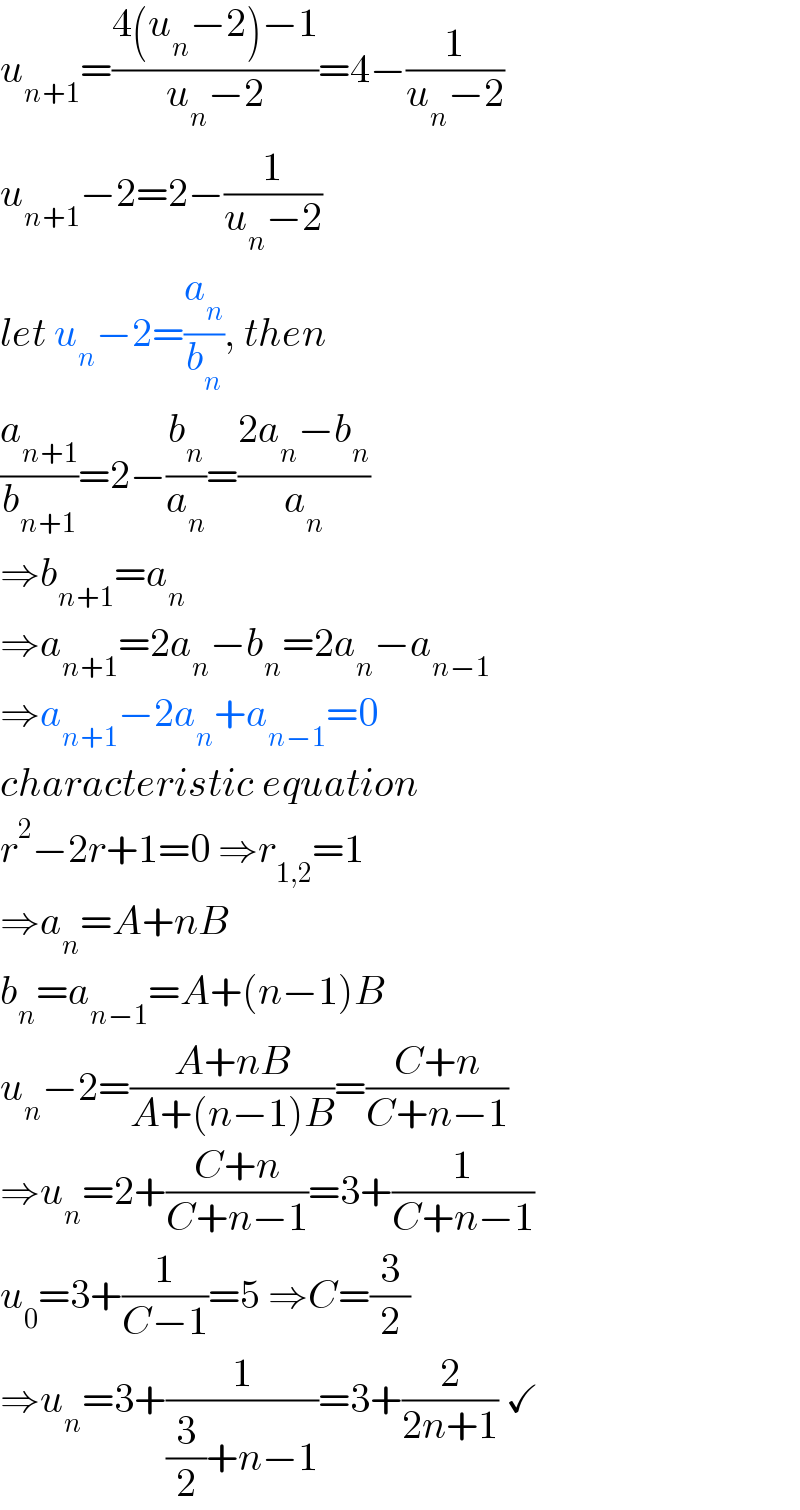
Question Number 214566 by mr W last updated on 12/Dec/24

$${somebody}\:{has}\:{posted}\:{following} \\ $$$${question}\:{and}\:{then}\:{deleted}\:{it}\:{again}. \\ $$$$\begin{cases}{{u}_{{n}+\mathrm{1}} =\frac{\mathrm{4}{u}_{{n}} −\mathrm{9}}{{u}_{{n}} −\mathrm{2}}}\\{{u}_{\mathrm{0}} =\mathrm{5}}\end{cases} \\ $$$${find}\:{u}_{{n}} =?\:\left({or}\:{something}\:{like}\:{this}\right) \\ $$
Answered by Hanuda354 last updated on 12/Dec/24

$$\left\{{u}_{{n}} \right\}\:=\:\left\{\:\mathrm{5},\:\frac{\mathrm{11}}{\mathrm{3}}\:,\:\frac{\mathrm{17}}{\mathrm{5}}\:,\:\frac{\mathrm{23}}{\mathrm{7}}\:,\:\ldots,\:\mathrm{3}\:+\:\frac{\mathrm{2}}{\mathrm{2}{n}+\mathrm{1}}\:\right\} \\ $$$$\:\mathrm{for}\:\:{n}\geqslant\mathrm{0}\: \\ $$
Commented by mr W last updated on 12/Dec/24

$${please}\:{share}\:{how}\:{you}\:{get}\:{this}. \\ $$
Commented by Hanuda354 last updated on 13/Dec/24

$$\mathrm{Using}\:\:\mathrm{iteration},\:\mathrm{we}\:\mathrm{get}: \\ $$$${u}_{\mathrm{1}} \:=\:\frac{\mathrm{4}\left(\mathrm{5}\right)−\mathrm{9}}{\mathrm{5}−\mathrm{2}}\:=\:\frac{\mathrm{11}}{\mathrm{3}} \\ $$$${u}_{\mathrm{2}} \:=\:\frac{\mathrm{4}\left(\frac{\mathrm{11}}{\mathrm{3}}\right)−\mathrm{9}}{\frac{\mathrm{11}}{\mathrm{3}}−\mathrm{2}}\:=\:\frac{\mathrm{17}}{\mathrm{5}} \\ $$$${u}_{\mathrm{3}} \:=\:\frac{\mathrm{4}\left(\frac{\mathrm{17}}{\mathrm{5}}\right)−\mathrm{9}}{\frac{\mathrm{17}}{\mathrm{5}}−\mathrm{2}}\:=\:\frac{\mathrm{23}}{\mathrm{7}} \\ $$$${u}_{\mathrm{4}} \:=\:\frac{\mathrm{4}\left(\frac{\mathrm{23}}{\mathrm{7}}\right)−\mathrm{9}}{\frac{\mathrm{23}}{\mathrm{7}}−\mathrm{2}}\:=\:\frac{\mathrm{29}}{\mathrm{9}} \\ $$$$\vdots \\ $$$${u}_{{n}} \:=\:\frac{\mathrm{6}{n}+\mathrm{5}}{\mathrm{2}{n}+\mathrm{1}}\:=\:\mathrm{3}\:+\:\frac{\mathrm{2}}{\mathrm{2}{n}+\mathrm{1}} \\ $$$$\mathrm{By}\:\mathrm{observing}\:\:\mathrm{the}\:\:\mathrm{pattern},\:\mathrm{we}\:\mathrm{can}\:\mathrm{conjecture}\:\mathrm{a}\:\mathrm{general} \\ $$$$\mathrm{formula}\:{u}_{{n}} \:: \\ $$$$\:\:\:\:\:\:\:{u}_{{n}} \:=\:\mathrm{3}\:+\:\frac{\mathrm{2}}{\mathrm{2}{n}+\mathrm{1}} \\ $$$$ \\ $$$$\mathrm{Proof}\:\mathrm{by}\:\mathrm{Induction}: \\ $$$$\mathrm{Base}\:\mathrm{case}:\:{u}_{\mathrm{0}} \:=\:\mathrm{3}+\frac{\mathrm{2}}{\mathrm{2}\left(\mathrm{0}\right)+\mathrm{1}}\:=\:\mathrm{5}\: \\ $$$$\mathrm{Assume}\:\mathrm{the}\:\mathrm{formula}\:\mathrm{holds}\:\mathrm{for}\:{n}={k}\:,\:\mathrm{i}.\mathrm{e},\:{u}_{{k}} \:=\:\mathrm{3}\:+\:\frac{\mathrm{2}}{\mathrm{2}{k}+\mathrm{1}}\:. \\ $$$$\mathrm{We}\:\mathrm{need}\:\mathrm{to}\:\mathrm{prove}\:\mathrm{it}\:\mathrm{holds}\:\mathrm{for}\:{n}\:=\:{k}+\mathrm{1}. \\ $$$$ \\ $$$$\:\:\:{u}_{{k}+\mathrm{1}} \:=\:\frac{\mathrm{4}{u}_{{k}} \:−\:\mathrm{9}}{{u}_{{k}} \:−\:\mathrm{2}}\:=\:\frac{\mathrm{4}\left(\mathrm{3}+\frac{\mathrm{2}}{\mathrm{2}{k}+\mathrm{1}}\right)−\mathrm{9}}{\mathrm{3}+\frac{\mathrm{2}}{\mathrm{2}{k}+\mathrm{1}}\:−\:\mathrm{2}} \\ $$$$\mathrm{Simplifying}\:\mathrm{the}\:\mathrm{expression},\:\mathrm{we}\:\mathrm{get}: \\ $$$$\:\:\:{u}_{{k}+\mathrm{1}} \:=\:\frac{\mathrm{3}\:+\:\frac{\mathrm{8}}{\mathrm{2}{k}+\mathrm{1}}}{\mathrm{1}\:+\:\frac{\mathrm{2}}{\mathrm{2}{k}+\mathrm{1}}}\:=\:\frac{\mathrm{6}{k}+\mathrm{11}}{\mathrm{2}{k}+\mathrm{3}}\:=\:\mathrm{3}\:+\:\frac{\mathrm{2}}{\mathrm{2}\left({k}+\mathrm{1}\right)+\mathrm{1}}\: \\ $$$$\mathrm{This}\:\mathrm{matches}\:\mathrm{the}\:\mathrm{formula}\:\mathrm{for}\:{n}\:=\:{k}+\mathrm{1}\:. \\ $$$$ \\ $$$$\mathrm{Therefore},\:\mathrm{the}\:\mathrm{solution}\:\mathrm{to}\:\mathrm{the}\:\mathrm{recurrence}\:\mathrm{relation}\:\mathrm{is}: \\ $$$$\:\:\:\:\:\:\:{u}_{{n}} \:=\:\mathrm{3}\:+\:\frac{\mathrm{2}}{\mathrm{2}{n}+\mathrm{1}} \\ $$
Commented by mr W last updated on 13/Dec/24
�� thanks!
Commented by mr W last updated on 13/Dec/24

$${i}'{ll}\:{post}\:{a}\:{more}\:{general}\:{method}\:{with} \\ $$$${which}\:{we}\:{can}\:{solve}\:{questions}\:{like} \\ $$$$\begin{cases}{{u}_{{n}+\mathrm{1}} =\frac{{au}_{{n}} +{b}}{{u}_{{n}} +{c}}}\\{{u}_{\mathrm{0}} ={d}}\end{cases} \\ $$
Answered by mr W last updated on 13/Dec/24

$${u}_{{n}+\mathrm{1}} =\frac{\mathrm{4}\left({u}_{{n}} −\mathrm{2}\right)−\mathrm{1}}{{u}_{{n}} −\mathrm{2}}=\mathrm{4}−\frac{\mathrm{1}}{{u}_{{n}} −\mathrm{2}} \\ $$$${u}_{{n}+\mathrm{1}} −\mathrm{2}=\mathrm{2}−\frac{\mathrm{1}}{{u}_{{n}} −\mathrm{2}} \\ $$$${let}\:{u}_{{n}} −\mathrm{2}=\frac{{a}_{{n}} }{{b}_{{n}} },\:{then} \\ $$$$\frac{{a}_{{n}+\mathrm{1}} }{{b}_{{n}+\mathrm{1}} }=\mathrm{2}−\frac{{b}_{{n}} }{{a}_{{n}} }=\frac{\mathrm{2}{a}_{{n}} −{b}_{{n}} }{{a}_{{n}} } \\ $$$$\Rightarrow{b}_{{n}+\mathrm{1}} ={a}_{{n}} \\ $$$$\Rightarrow{a}_{{n}+\mathrm{1}} =\mathrm{2}{a}_{{n}} −{b}_{{n}} =\mathrm{2}{a}_{{n}} −{a}_{{n}−\mathrm{1}} \\ $$$$\Rightarrow{a}_{{n}+\mathrm{1}} −\mathrm{2}{a}_{{n}} +{a}_{{n}−\mathrm{1}} =\mathrm{0} \\ $$$${characteristic}\:{equation} \\ $$$${r}^{\mathrm{2}} −\mathrm{2}{r}+\mathrm{1}=\mathrm{0}\:\Rightarrow{r}_{\mathrm{1},\mathrm{2}} =\mathrm{1} \\ $$$$\Rightarrow{a}_{{n}} ={A}+{nB} \\ $$$${b}_{{n}} ={a}_{{n}−\mathrm{1}} ={A}+\left({n}−\mathrm{1}\right){B} \\ $$$${u}_{{n}} −\mathrm{2}=\frac{{A}+{nB}}{{A}+\left({n}−\mathrm{1}\right){B}}=\frac{{C}+{n}}{{C}+{n}−\mathrm{1}} \\ $$$$\Rightarrow{u}_{{n}} =\mathrm{2}+\frac{{C}+{n}}{{C}+{n}−\mathrm{1}}=\mathrm{3}+\frac{\mathrm{1}}{{C}+{n}−\mathrm{1}} \\ $$$${u}_{\mathrm{0}} =\mathrm{3}+\frac{\mathrm{1}}{{C}−\mathrm{1}}=\mathrm{5}\:\Rightarrow{C}=\frac{\mathrm{3}}{\mathrm{2}} \\ $$$$\Rightarrow{u}_{{n}} =\mathrm{3}+\frac{\mathrm{1}}{\frac{\mathrm{3}}{\mathrm{2}}+{n}−\mathrm{1}}=\mathrm{3}+\frac{\mathrm{2}}{\mathrm{2}{n}+\mathrm{1}}\:\checkmark \\ $$
